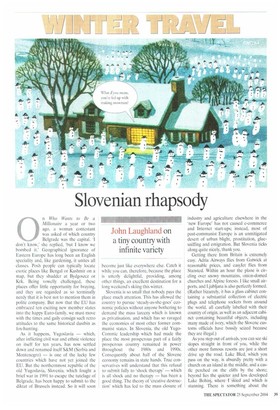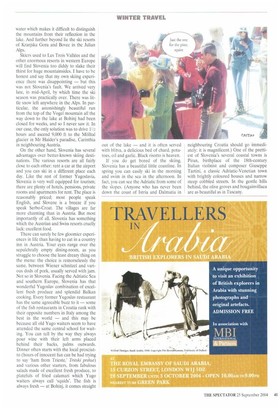Slovenian rhapsody
John Laughland on a tiny country with infinite variety
0 n Who Wants to Be a Millionaire a year or two ago, a woman contestant was asked of which country Belgrade was the capital. 'I don't know,' she replied, but I know we bombed it.' Geographical ignorance of Eastern Europe has long been an English speciality and, like gardening, it unites all classes. Posh people can typically locate exotic places like Bengal or Kashmir on a map, but they shudder at Bydgoszcz or Krk. Being vowelly challenged, these places offer little opportunity for braying, and they are regarded as so terminally nerdy that it is best not to mention them in polite company. But now that the EU has embraced ten exciting new member states into the happy Euro-family, we must move with the times and gaily consign such retro attitudes to the same historical dustbin as fox-hunting.
As it happens, Yugoslavia — which, after inflicting civil war and ethnic violence on itself for ten years, has now settled down and renamed itself S&M (Serbia and Montenegro) — is one of the lucky few countries which have not yet joined the EU. But the northernmost republic of the old Yugoslavia, Slovenia, which fought a brief war in 1991 to escape the tutelage of Belgrade, has been happy to submit to the diktat of Brussels instead. So it will soon become just like everywhere else. Catch it while you can, therefore, because the place is utterly delightful, providing, among other things, an excellent destination for a long weekend's skiing this winter.
Slovenia is so small that nobody pays the place much attention. This has allowed the countty to pursue 'steady-as-she-goes' economic policies without anyone bothering to demand the mass larceny which is known as privatisation, and which has so ravaged the economies of most other former communist states, In Slovenia, the old YugoCommie leadership which had made the place the most prosperous part of a fairly prosperous country remained in power throughout the 1980s and 1990s. Consequently about half of the Slovene economy remains in state hands. True conservatives will understand that this refusal to submit fully to 'shock therapy' — which is all shock and no therapy — has been a good thing. The theory of 'creative destruction' which has led to the mass closure of industry and agriculture elsewhere in the 'new Europe' has not caused e-commerce and Internet start-ups; instead, most of post-communist Europe is an unmitigated desert of urban blight, prostitution, gluesniffing and emigration. But Slovenia ticks along quite nicely, thank you.
Getting there from Britain is extremely easy. Adria Airways flies from Gatwick at reasonable prices, and easyJet flies from Stansted. Within an hour the plane is circling over snowy mountains, onion-domed churches and Alpine forests. I like small airports, and Ljubljana is also perfectly formed. (Rather bizarrely, it has a glass cabinet containing a substantial collection of electric plugs and telephone sockets from around the world, all carefully labelled with their country of origin, as well as an adjacent cabinet containing beautiful objects, including many made of ivory, which the Slovene customs officials have bossily seized because they are illegal.)
As you step out of arrivals, you can see ski slopes straight in front of you, while the other more famous resorts are just a short drive up the road. Lake Bled, which you pass on the way, is absurdly pretty with a church on an island in the middle, and a castle perched on the cliffs by the shore; beyond lies the quieter and less developed Lake Bohinj, where--I skied and which is stunning. There is something about the water which makes it difficult to distinguish the mountains from their reflection in the lake. And further beyond lie the ski resorts of Kranjska Gora and Bovec in the Julian Alps.
Skiers used to Les Trois Vallees and the other enormous resorts in western Europe will find Slovenia too diddy to slake their thirst for huge mountainsides, I have to be honest and say that my own skiing experience there was disappointing — but this was not Slovenia's fault. We arrived very late, in mid-April, by which time the ski season was practically over. There was little snow left anywhere in the Alps. In particular, the astonishingly beautiful run from the top of the Vogel mountain all the way down to the lake at Bohinj had been closed for weeks, and so I never saw it. In our case, the only solution was to drive 11/2 hours and ascend 9,000 ft to the Mblltal glacier in Mr Haider's paradise, Carinthia in neighbouring Austria.
On the other hand, Slovenia has several advantages over better-known skiing destinations. The various resorts are all fairly close to each other: rent a car at the airport and you can ski in a different place each day. Like the rest of former Yugoslavia, Slovenia is very well equipped for tourism; there are plenty of hotels, pensions, private rooms and apartments for rent. The place is reasonably priced; most people speak English, and Slovene is a breeze if you speak Serbo-Croat. The villages are far more charming than in Austria. But most importantly of all, Slovenia has something which the Austrian and Swiss resorts cruelly lack: excellent food.
There can surely be few gloomier experiences in life than having to eat in a country inn in Austria. Your eyes range over the sepulchrally empty dining-room, as you struggle to choose the least dreary thing on the menu: the choice is remorselessly the same, between Wiener schnitzel and various dods of pork, usually served with jam. Not so in Slovenia. Facing the Adriatic Sea and southern Europe, Slovenia has that wonderful Yugoslav combination of excellent fresh produce and splendid Balkan cooking, Every former Yugoslav restaurant has the same agreeable buzz to it — some of the fish restaurants in Croatia rank with their opposite numbers in Italy among the best in the world — and this may be because all old Yugo waiters seem to have attended the same central school for waiting. You can tell by the way they always pour wine with their left arms placed behind their backs, palms outwards, Dinner often starts with the local prosciutto (hours of innocent fun can be had trying to say tam from Trieste,' Trstski prshut) and various other starters, from fabulous salads made of excellent fresh produce, to platefuls of fried calamari which Yugo waiters always call 'squids'. The fish is always fresh — at Bohinj, it comes straight out of the lake — and it is often served with blitva, a delicious bed of chard, potatoes, oil and garlic. Black risotto is heaven.
If you do get bored of the skiing, Slovenia has a beautiful little coastline. In spring you can easily ski in the morning and swim in the sea in the afternoon. In fact, you can see the Adriatic from some of the slopes. (Anyone who has never been down the coast of Istria and Dalmatia in neighbouring Croatia should go immediately: it is magnificent.) One of the prettiest of Slovenia's several coastal towns is Piran, birthplace of the 18th-century Italian violinist and composer Giuseppe Tartini, a classic Adriatic-Venetian town with brightly coloured houses and narrow steep cobbled streets. In the gentle hills behind, the olive groves and bougainvillaea are as beautiful as in Tuscany.



























































































 Previous page
Previous page